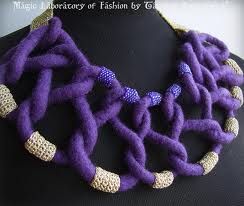|
In the Byzantine Empire jewelry played an important role. It acted as a way to express ones status and as a diplomatic tool. In 529 AD Emperor Justinian took up laws regulating the wearing and usage of jewelry in a new set of laws, later to be called the Justinian Code. He explicitly writes that sapphires, emeralds and pearls are reserved for the emperor's use but every free man is entitled to wear a gold ring. With its rope-like texture and intriguing textural design, a Byzantine necklace adds a touch of continental class to nearly any outfit.

Wearing richly ornamented gold necklaces was a common practice among elite members of society in the late Roman and Byzantine Empire. In the Christianized Roman Empire, necklaces with cross pendants and amuletic capsules functioned as objects of personal adornment and symbols of social status as well as powerful protective devices. While Christian theologians were not always comfortable with the use of protective amulets, especially if they contained undisclosed texts or substances, their existence is well attested.

Gemstones were often were rounded (if not already done by nature), polished and then drilled. A gold wire would then be passed through the drill hole and bent into a loop on either side of the gem. This way the gemstones could be attached to one another to form necklaces, pendant earrings, headwear or bracelets.
The typical Byzantine jewelry box would have been filled well. From headwear to earrings and necklaces to body chains, bracelets and rings, just about every possibility to decorate one’s body was used. Large gem-set necklaces were in favor with the ladies while men wore pectoral ornaments, often coin based which may have served as military decorations or some other status symbol. The classical loop-in-loop chains were substituted by linked (open worked) discs and/or linked gem beads to form necklaces.

Pieces of jewelry were given at births or marriages and often accompanied their owners into the afterlife, as well (many early jewelry pieces have been discovered in the excavation of graves). Jewelry was used in early Greek religion as amulets, or as offerings to the gods-a practice continued into Christianity with votive offerings. Jewelry is also symbolic of Greek nationalism and cultural heritage.
The Late Bronze age saw the development of the Mycenaean civilization, the first great Greek civilization. Jewelry in this period was made of gold mainly. Necklace relief beads and pendants were popular, along with rings. Silver, bronze and lead were sometimes used, but not as often as gold. Alloys also were being used, valued for their strength. When the Mycenaean civilization collapsed, Greek culture lapsed into a "dark age" from around 1100 BCE to 800 BCE.
|

![]()


